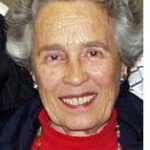By Eileen Wingard

SAN DIEGO — The German violinist, Anne-Sophie Mutter; the Spanish cellist, Pablo Ferrandez; and the Russian-Israeli pianist, Yefim Bronfman, joined forces to deliver definitive performances of Beethoven’s Archduke Trio and Tchaikovsky’s Trio at the Balboa Theater last Saturday evening.
Under the auspices of the La Jolla Music Society, the three internationally acclaimed soloists melded their instrumental voices, a Stradivarius violin, a Stradivarius cello and a Steinway piano, into an ensemble of rare beauty.
The Archduke Trio is considered Beethoven’s finest work in that medium, with noble melodies and grand structure. The first movement’s opening theme was presented by the piano. Bronfman played with delicacy when accompanying the strings and with boldness when in the forefront, eschewing any histrionics.
The spiccato notes of the cello, answered by the violin, opened the playful Scherzo movement and a somber hymn-like chorale melody began the slow movement’s theme and variations. The finale movement was a spirited Rondo.
Beethoven dedicated the Archduke Trio to Austria’s Archduke Rudolf, grandson of Maria Theresa, who was Beethoven’s piano and composition student. In addition to this trio, the composer also dedicated his Missa solemnis, the Grosse Fuge, and the Hammerklavier Sonata to this loyal friend and patron. Beethoven, himself, premiered the work in 1814, but his increased deafness impeded his ability. That was his last public performance as a pianist.
Tchaikovsky wrote his two-movement trio in memory of his mentor, Nikolai Rubinstein. Nikolai and his elder brother, Anton, were born to Jewish parents, but when Anton was five years old, their grandfather had the family converted to Russian Orthodoxy. Both Rubinstein brothers were outstanding pianists, and both were composers.
Anton was the founder of the St. Petersburg Conservatory, where Tchaikovsky studied, and Nikolai was founder of the Moscow Conservatory, where Tchaikovsky was on the faculty. When Nikolai died at age 46 of tuberculosis, Tchaikovsky was inspired to compose this trio with its inscription, “In Memory of a Great Artist.”
The cello’s opening theme of the first movement sounds almost like a Hebrew prayer in its minor modality and was played most expressively by Ferrandez. The response from the violin reinforced the poignant lament. The theme came back in several guises. In the middle, it was repeated in the lower reaches of the violin with introspective beauty, finally, in the piano, with sobbing sounds from the strings.
The second movement is a theme and twelve variations. The theme is based on a song Nikolai wrote and taught to local peasants when the conservatory students, led by their director, went on a picnic. The many variations include a waltz, a mazurka and a fugue. It concludes by bringing back the opening theme of the first movement, this time as a funeral march with the violin and cello playing the theme in octaves. Finally, the cello and violin exchange phrases, with the piano having the last say as the music fades away.
The ovation for these three consummate artists was so extensive that they returned to play an encore: The Theme from Schindler’s List by John Williams.
Their choice brought tears to my eyes. This marked a week after Yom Hashoah, the commemoration of the loss of six million Jewish lives in the Holocaust. This was music from the iconic Holocaust film directed by Steven Spielberg. It was performed with great feeling by German violinist, Anne-Sophie Mutter, Spanish cellist, Pablo Ferrandez and Jewish pianist, Yefim Bronfman.
If only music had the power to bring us to live together in harmony and peace.
*
Eileen Wingard, a retired violinist with the San Diego Symphony, is a freelance writer specializing in coverage of the arts.